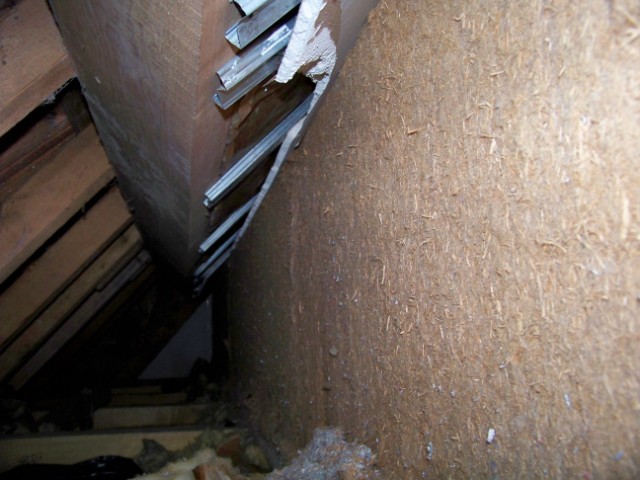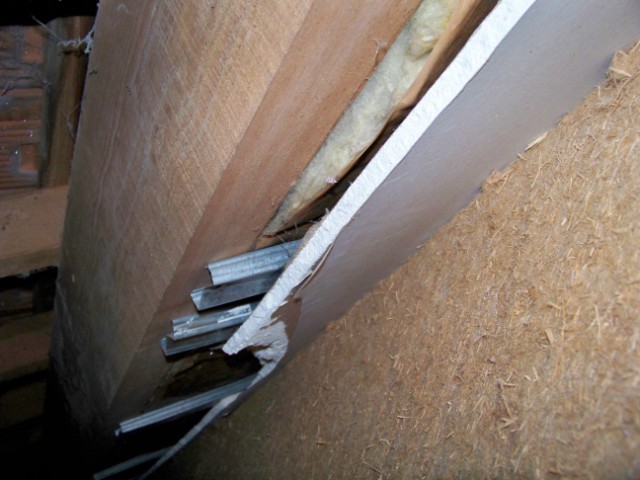Appearance of wet spots on my placo
moby25 wrote:
I noticed that in the morning we always had a very high humidity: 80% or more. But only the hygrometer tells us, because no smell of mold or humidity. I also have the window of my velux window which is soaked.
So it seems to me more than likely that at cold spots, it condenses. If "in the middle" of your room, with air at I don't know 17 ° C (??? °, you have 80% RH, it is sure that in places where the surface would be clearly pls cold, it condenses (the exact temperatures should be checked in charts).
Measure see the surface temperature in places where it condenses?
Maybe your problem is a ventilation problem (VMC)?
0 x
-
Christophe
- Moderator

- posts: 79386
- Registration: 10/02/03, 14:06
- Location: Greenhouse planet
- x 11074
dedeleco wrote:It can be condensation as well as a leak from the roof (cracked, broken tiles, to be checked on the roof carefully before any demolition, otherwise risk regretting these demolitions !!) !!)
I could be wrong but I think that if it was a leak on the roof, the spots would not be in string like on the photo ... that is to say that they would be much more concentrated ... and that he would have noticed it during heavy rains ...
But in fact it can very well have 2 phenomena: a small crack on the roof which created an undetectable infiltration which screwed up the insulation which is now ineffective, hence thermal bridge and condensation ...
0 x
Do a image search or an text search - Netiquette of forum
-
Christophe
- Moderator

- posts: 79386
- Registration: 10/02/03, 14:06
- Location: Greenhouse planet
- x 11074
A lathing, a scrap of wood wool or polystyrene ... there are plenty of methods to plug a hole, isn't it Remundo?
But if it is the outside air passing, we must also ask where it comes from ...
But if it is the outside air passing, we must also ask where it comes from ...
0 x
Do a image search or an text search - Netiquette of forum
Weird, I advise you to understand my personal method before acting, but it is sometimes detective work on the slightest clues !!
it is necessary to determine if the condensation is done inside hot on very cold plasterboard (room with interior humidity, showers, baths, humans who breathe in large numbers, kitchen, etc ...) or on the outside side with hot humid air which leaks and condenses on exterior cold spots and whose condensation wets the plasterboard.
Strange, because if inside, the plasterboard is only wet on the inside and the outside is dry with the dry glass wool; because if outside, the glass wool against the plasterboard will be wet with the plasterboard on the outside.
so check carefully that you have looked at the tiles and the wool underneath dry in the correct place where you have interior moisture visible on the plasterboard, to avoid any misjudgment.
Indeed if the plasterboard and its glass wool against are dry on the exterior side with complete certainty (to be tested with great care), then the condensation occurs on the interior side, and therefore the source of interior humidity must be reduced by ventilating (VMC) , by taking fewer baths and showers, etc., by insulating this area better with glass wool (measure these cold spots on the plasterboard with a thermometer).
It's weird, because you insulate better with glass wool and you have new cold spots that weren't there without insulation ????? ???
So try to understand these contradictions by looking for clues, otherwise you risk working unnecessary modifications for nothing !!
Unless the fixing rails lead the cold outside on the plasterboard ???
a test: try to dry this empty room, with no one inside, the door closed, with a dehumidifier and no source of humidity: if there is interior condensation, the humidity will disappear, otherwise it will persist.
I looked tonight and did not see a crack.
The glass wool below the tiles is not soaked.
So I think this is a phenomenon of condensation ...
Do I have to seal the bottom part of the glass wool perfectly? so that there is absolutely no air that can pass.
it is necessary to determine if the condensation is done inside hot on very cold plasterboard (room with interior humidity, showers, baths, humans who breathe in large numbers, kitchen, etc ...) or on the outside side with hot humid air which leaks and condenses on exterior cold spots and whose condensation wets the plasterboard.
Strange, because if inside, the plasterboard is only wet on the inside and the outside is dry with the dry glass wool; because if outside, the glass wool against the plasterboard will be wet with the plasterboard on the outside.
so check carefully that you have looked at the tiles and the wool underneath dry in the correct place where you have interior moisture visible on the plasterboard, to avoid any misjudgment.
Indeed if the plasterboard and its glass wool against are dry on the exterior side with complete certainty (to be tested with great care), then the condensation occurs on the interior side, and therefore the source of interior humidity must be reduced by ventilating (VMC) , by taking fewer baths and showers, etc., by insulating this area better with glass wool (measure these cold spots on the plasterboard with a thermometer).
It's weird, because you insulate better with glass wool and you have new cold spots that weren't there without insulation ????? ???
So try to understand these contradictions by looking for clues, otherwise you risk working unnecessary modifications for nothing !!
Unless the fixing rails lead the cold outside on the plasterboard ???
a test: try to dry this empty room, with no one inside, the door closed, with a dehumidifier and no source of humidity: if there is interior condensation, the humidity will disappear, otherwise it will persist.
0 x
That night, we slept with the door open, humidity 65% and no condensation ... However, there is still quite a lot of condensation on my double glazing.
I spotted with a wood pencil the points where I had condensation yesterday and it is much cooler in these places.
I could see where it's coming from and fix it by un-tiling, but I'm not very well equipped to work on my roof, my ladder is a bit short.
christophe -> in fact I was asking how to seal the base of the crawlers where the glass wool arrives. In fact I would like to know what type of "scotch" I should use. A specific vapor barrier?
I spotted with a wood pencil the points where I had condensation yesterday and it is much cooler in these places.
I could see where it's coming from and fix it by un-tiling, but I'm not very well equipped to work on my roof, my ladder is a bit short.
christophe -> in fact I was asking how to seal the base of the crawlers where the glass wool arrives. In fact I would like to know what type of "scotch" I should use. A specific vapor barrier?
0 x
So, very likely it is the condensation of the water emitted by your breathing while sleeping that condenses on a cold point or thermal bridge, behind the plasterboard, as on the double glazing which is even colder than the insulation by glass wool.
Strange, nevertheless, because you put glass wool, unless your angle iron makes a thermal bridge or the glass wool is wet or badly put in this place ???
The easiest way is to ventilate well, to renew with fairly dry air, difficult in rainy weather.
You have for around 100 € small dehumidifiers (small fridge) which condense the water and avoid condensing it in excess on the irremovable thermal bridges sometimes in apartment.
Buy a roofer's ladder to go to the roof and look under the tiles to see better what you have done wrong in the thermal bridging glass wool.
Strange, nevertheless, because you put glass wool, unless your angle iron makes a thermal bridge or the glass wool is wet or badly put in this place ???
The easiest way is to ventilate well, to renew with fairly dry air, difficult in rainy weather.
You have for around 100 € small dehumidifiers (small fridge) which condense the water and avoid condensing it in excess on the irremovable thermal bridges sometimes in apartment.
Buy a roofer's ladder to go to the roof and look under the tiles to see better what you have done wrong in the thermal bridging glass wool.
0 x
Bonsoir
after a long time, I will put 2 photos of the back part of the insulation which may be the cause of the cold spots


We see that between the glass wool and the plasterboard, a little air can pass;
In the same way for the rails, it is possible that it conducts the cold;
What do you think ?
How could I correct the problem
please
after a long time, I will put 2 photos of the back part of the insulation which may be the cause of the cold spots
We see that between the glass wool and the plasterboard, a little air can pass;
In the same way for the rails, it is possible that it conducts the cold;
What do you think ?
How could I correct the problem
please
0 x
Back to "Heating, insulation, ventilation, VMC, cooling ..."
Who is online ?
Users browsing this forum : No registered users and 156 guests


